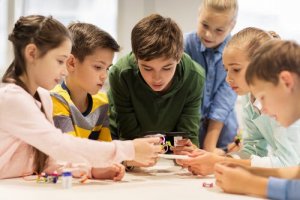What's Interactive Learning About?

Many psychologists, biologists, and mathematicians concern themselves with the learning process and already made a contribution in an attempt to improve the general understanding of this process. Continue reading to find out more about interactive learning.
Let’s start by defining learning and interaction. According to the dictionary, the first concept refers to “acquisition by the practice of lasting behavior” and the second to an “the action exercised between two or more objects, people, agents, forces, and functions”. But what exactly is interactive learning?

Interactive learning
It consists of dynamic learning, commonly associated with movement. Its main characteristics are that it provides motivating activities that encourage a person to stay active and deepen their knowledge. For this, various actors and elements are necessary:
- Teacher. Works as a leader that motivates learning.
- Students. They stay active during learning.
- Space. It may or may not be a classroom; the important thing is for it to be conducive to learning.
In interactive learning, one can include various tools to help achieve a set of goals. For instance, a recurring one is to keep learning. This way, you avoid procrastination.
How to teach interactively
It’s important for constant dialogue to be the foundation of active learning. The idea is for the teacher to become more involved in learning in a global way. In other words, to go beyond the theoretical.
In tune with the environment and the goals, the teacher:
- Plans the learning process.
- Intervenes to motivate learning and guide students.
- Supervises the work of the students.
- Is open to dialogue.
- Generates positive expectations about the content they’re addressing.
- Is innovative when it comes to the learning process.
- Is dynamic and in tune with the curricular process.
Thus, the teacher acts as a facilitator for learning. For this, in addition to the aforementioned characteristics, they must know and manage themselves well. Therefore, in this type of learning, the emotions, cognitions, and behaviors also count. In fact, this person must set an example. They teach and students appreciate, repeat, and recreate what they learned.
In addition, interactive learning intelligence is considered comprehensive. Thus, its only goal isn’t the development of intellectual pursuits. It takes artistic, cultural, empathic, and self-regulatory skills. The teacher is a guide and must be aware of and help enhance these capabilities. Fantastic, right?
Interactive learning
When it comes to interactive learning, the student has an active role and, therefore, they can participate in all activities. Making a presentation, for example. Furthermore, they get feedback. Not only from their teacher but also from their classmates and even from themselves. They can work in:
- A flipped classroom. Here, they can develop virtual and face-to-face strategies. In addition, the student can develop various skills that will allow them to learn comprehensively.
- Activities that promote competency learning. This consists of learning step by step until they develop a certain competence.
- Interaction with resources. Technological and not, it consists of a student relating to various tools that facilitate learning. For example, participating in a brainstorming session in a virtual and shared space, making a presentation, and learning through games.

Final notes
There are many places dedicated to education that have made interactive learning their flag. What’s important here is to look for them if you want to be part of this model, which is getting stronger and richer with each technological advance. It isn’t just present in grade schools but it’s also evident in higher education.
There have been studies about virtuality incorporated into learning. In an article published in the journal Media and Education, Arenas Márquez, Domingo Carrillo, Molleda Jimena, Ríos Martín, and Ruiz del Castillo (2009) suggest that it isn’t enough to transfer the classic materials to a website, as you also have to adapt them to the new space. Thus, it isn’t only about mixing but rather a type of learning that’s innovative but directed, supervised, and with a strong theoretical base.
In short, interactive learning emphasizes a relationship built in various environments, in which teachers, students, and classmates become involved in a dynamic and conscious manner. One in which each participant contributes something. It goes beyond classic learning models, integrating them into an innovative proposal.
All cited sources were thoroughly reviewed by our team to ensure their quality, reliability, currency, and validity. The bibliography of this article was considered reliable and of academic or scientific accuracy.
Márquez, F.J.A., Carrillo, M. Á. D. Jimena, G.M. Martín, M. Á.R. & del Castillo, J.C.R. (2009). Aprendizaje interactivo en la educación superior a través de sitios web. Un estudio empírico. Pixel-Bit. Revista de Medios y Educación (35),127-145.
This text is provided for informational purposes only and does not replace consultation with a professional. If in doubt, consult your specialist.








